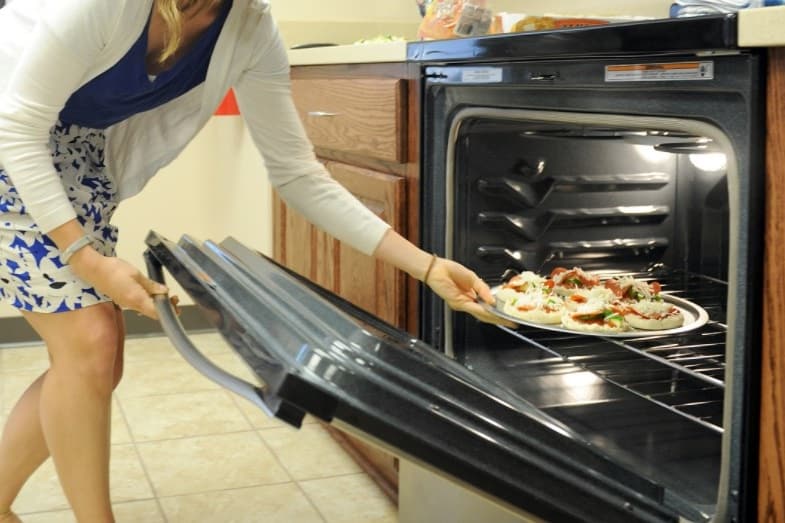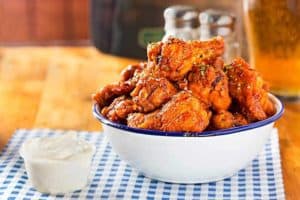Can you put cardboard in the oven when the oven is on? Do you want to put your leftover pizza with its cardboard box inside the oven in the hope of reheating it? I don’t recommend it unless you want to risk lighting up a fire in your oven. In this article, I’ll describe what happens when you put cardboard in the oven and why this shouldn’t be done.
Can cardboard go in the oven? Cardboard doesn’t catch fire until you subject it to heat over 400°F. So, while you could keep the oven temperature below 400°F, it is not advisable to put cardboard in the oven while the oven is on.
The cardboard could easily catch fire if it touches or even is close to the hot heating element in the oven. Some cardboard also has flammable chemicals in it that could cause ignition at a lower temperature.
It is tempting to stick a delivered pizza, in the cardboard box, in the oven to heat it. However, this is a bad idea, even at temperatures below 400°F. Along with the reasons mentioned above, grease from the pizza box can also cause the box to ignite at lower temperatures.
Read on to learn more about putting cardboard in the oven, what will happen if you do, and why it isn’t recommended.
Can You Put Cardboard in the Oven?
While many people say that they have done so, it is not really safe to heat cardboard in the oven. Cardboard is made of paper, which is very combustible. Therefore, it can easily catch fire when exposed to high temperatures for several minutes.
If there’s no other way but to heat your pizza in its cardboard box, you should keep the temperature at a safe limit of 170°F and at the shortest possible time. Also, consider other safer ways of reheating cold pizzas.
Can cardboard go in the oven? Normally, cardboards will not burn unless heated to more than 400°F. However, there are certain types of cardboard that contain flammable chemicals. And you won’t know if the type of cardboard that you want to put in the oven has these chemicals.
You should also realize that pizza contains oil and other greasy substances that can splatter on the cardboard box. Paper with grease and oil can easily catch fire when exposed to too much heat. If you heat the pizza in its box full of grease and oil and then turn the temperature at high levels, you may kindle a fire inside the oven.
Heating Pizza in Its Cardboard Box Is Not Advisable
Did you ever wonder why pizza comes in cardboard boxes? Aside from their convenience, the design of these boxes keeps the pizza warm. Of course, if you forget the box for many hours at room temperature, the pizza inside will get cold.
Consider this reason why it is not recommended to heat pizza boxes inside the oven: paper can quickly catch fire when exposed to very high heat. Some cardboard boxes are basically made of recycled paper. Therefore, they can also catch fire very easily. Most types of cardboard are made by gluing several pieces of paper. Glue also catches fire quickly.
Here is another reason: if you heat the pizza inside its cardboard box, you will ruin its taste. Most pizza boxes have thin layers of paper that heat up easily. This thin layer of paper also contains certain chemicals.
If this layer of paper burns out, it will leave a bitter taste on the pizza. Your pizza will also smell like cardboard. What happens is that the cardboard material heats up faster than the pizza. So, if you place the box inside the oven to heat the pizza, it won’t heat the pizza evenly.
How You Can Keep Pizza Warm at Your Party
Your guests won’t like to eat stone-cold slices of pizza. That’s why you really need to keep them warm. There’s no need to reheat pizza if you can keep them warm. Below are some tips on how you can keep pizza warm.

1. Oven Rack
It is the easiest way to keep your pizza warm out of its box.
- Set your oven at 170°F.
- Turn it on.
- Remove the pizza from its cardboard box and place it inside the oven.
- Keep it there for a few minutes and serve it to your guests at their pleasure.
2. Aluminum Foil
You can keep pizza warm for more than three hours if you use aluminum foil.
- Separate the slices of pizza and wrap them individually in aluminum foil.
- Set the oven at 400°F and turn it on.
- Place the pizza inside the oven for 10 minutes.
This process will heat the slices of pizza but will not overcook them. The pizza will also taste fresh. But don’t go beyond 400°F to avoid burning them.
3. Frying Pan
The frying pan is also good for keeping pizza warm. If your oven is overloaded with food, your frying pan can help.
- Use a non-stick pan, preferably made of stainless steel.
- Place the pan on an open stove set at high heat.
- Place the pizza on the pan and heat it for 2 minutes. Check if the bottom gets crispy, not burnt.
- Cover the pan with a lid to warm the pizza sauce and allow the cheese to melt.
- Serve the pizza according to the pleasure of your guests.
4. Microwave
The keys to using the microwave for warming pizza are to use the right dish, the right setting, and the exact timing.
- Place your pizza slices on a spacious microwave oven-safe dish.
- Get a ceramic bowl or dish and pour water on it until it is 2/3 full.
- Place this bowl inside the microwave.
- Place the dish containing the pizzas on top of the bowl.
- Set the microwave at half power.
- Heat the pizza at one-minute intervals.
The water in the bowl will evaporate with increasing heat. This method will keep the pizza crusts moist and not chewy. Heating at intervals will enable you to control the temperature, too.
If You Insist, Here’s a Safe Way to Heat Pizza in a Box
Admittedly, heating pizza inside its box is very convenient since you won’t need an oven-safe dish to reheat it in the oven. So, if you insist on heating pizza in its box, here is how you can safely do it.
- First, set the oven at the lowest temperature and turn it on. This temperature would often be at 170°F.
- Keep the steam flaps of the pizza box open. Opening them will prevent the pizza crust from getting chewy.
- Place the pizza box inside the oven for several minutes.
You will not overcook your pizza or make them soggy if you follow the above steps. Moreover, the paper fibers in the cardboard will retain the heat and create an oven-like environment to keep the pizza warm. But remember, your pizza can have a cardboard smell. This smell is due to the cardboard’s thin layer of chemicals that burns as you heat it.
Three Best and Safest Ways to Reheat Leftover Pizza
Your guests did not consume all the pizza you ordered last night, so you stored them in the fridge. Cold pizza is good, but it is better when it is reheated. Here are the three best methods of reheating pizza.
1) Reheat Them on the Stovetop
- Put the pan over medium heat.
- Place the pizza slices on the pan and heat them for a few minutes. Don’t cover the slices.
- Next, add a few drops of water on the side of the pan.
- Cover the pan and heat the slices of pizza for another couple of minutes.
2) Reheat the Slices in the Microwave
- Place the pizza slices on an oven-safe dish.
- Set the microwave at 30 to 40 percent power.
- Put the dish with the pizza slices inside the microwave oven and heat them for 45 seconds.
3) Reheat the Pizza in the Oven
- Preheat your oven to 350°F.
- Wrap the pizza with aluminum foil and put it on the oven rack.
- Wait 10 minutes until the pizza is warm and the cheese has melted.
We’ve answered the question, “Can you put cardboard in the oven?” Next, let’s look at what other materials can and cannot go in the oven when it is on.
What Materials Can and Can’t Go into the Oven?
There’s a real danger in putting the wrong types of cookware inside the oven. Therefore, you really need to be sure that the dish you put inside your oven will not explode or catch fire. To that end, I am listing the materials that can and can’t go inside the oven.

A) Oven-Safe Materials
1. Ceramic
Glazed ceramic dishes are fully oven-safe. Be sure to use ceramic dishes that can take high temperatures without leaching their chemicals into the food that you are heating or cooking.
Glazed ceramic pans are very popular for cooking and baking lasagna, quiches, and tagines. Most of them are oven-safe, too. You can also use tableware porcelain in the oven. But limit the use of porcelain, especially if they are intricately decorated. Only use them for short heating periods.
You can also use unglazed ceramics. But ensure that they can be safely used in the oven. There are earthenware types that can crack due to very high heat. So, they can’t go into the oven.
2. Metal
Cookware made of metal is perfectly safe in the oven. Some of these metals have non-reactive properties, like stainless steel, while some have reactive properties with protective layers, such as seasoned cast iron. Both can go inside the oven.
But even if they are made with safe metal materials, those containing non-metal parts should not go into the oven. For instance, if a stainless steel pan has a plastic handle, it should not be used in the oven. However, if the plastic material is oven-rated, it is safe.
But then, if the non-metal part is only rated at 400°F, don’t subject the pan to 450°F. Please remember that you should not subject PTFE (non-stick) coated cookware to heat that is more than 482°F or 250°C.
3. Silicone
Food-grade silicone cookware is perfect for oven cooking and baking. Silicone is a type of material that high oven temperatures can’t destroy. However, if your silicone cookware is rated at a certain oven temperature, don’t exceed it. Most silicone cookware can hold up to high oven temperatures of 400°F.
4. Glass
Glass cookware, especially those made of borosilicate, is perfectly safe inside the oven. But they are not good at temperature shocks. If you expose them to sudden extreme temperature changes, they will break.
For instance, don’t prepare layers of lasagna on a glass pan, put it in the freezer overnight, and then bake it straight into the oven in the morning. That will easily shatter the cookware into harmful shards of glasses.
There are two types of glass cookware: borosilicate and soda-lime. Their manufacturers claim they are both safe to use in the oven. Just be sure to check out the markings on your glassware if they really are.
B) Unsafe Oven Materials
1. Wood
You should not place all dishes made of wood inside the oven. Some of them may not catch fire at low oven temperatures, but the heat will still damage the material. You won’t be able to use the wooden cookware the same as before.
The wood may be warped, the glued parts may be damaged, and the surface might not be as smooth as before. Don’t take the risk. Although wood is thick, it will still get damaged if you subject it to heat for a while.
2. Plastic
Some plastics can withstand heat. But how can you be sure if the plastic dish can take the heat of your oven? So far, there has not been any plastic dish manufacturer that claims to have produced oven-safe plastic dishes. To be safe, don’t put any kind of plastic inside your oven.
Conclusion – Can Cardboard Go in the Oven?
So, to recap, can you put cardboard in the oven? Cardboard doesn’t catch fire until you subject it to temperatures of more than 400°F. Even if you could keep the oven temperature below 400°F, it is still not safe to put cardboard in the oven while it is on.
If the cardboard touches the burner, it could catch fire. And if the cardboard contains flammable chemicals, it can ignite even at lower temperatures. So avoid putting cardboard in the oven to avoid starting a fire.



